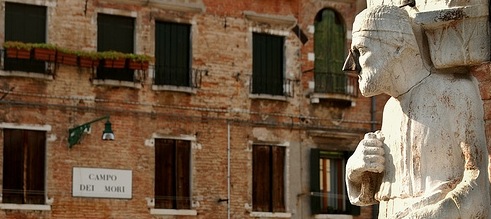
Crossing Campo dei Mori yesterday, on the way home from a magnificent row through the barene north of Burano followed by an abundant fish frittura hosted by the Voga e Para rowing club, I was stopped in my tracks when I glanced up at the familiar Moro merchant with the iron nose eternally perched on the corner of the campo to see that he’d be violently vandalized: someone had removed his entire head.
As reported in yesterday’s Gazzettino:
“The marble head of the statue “Sior [Antonio] Rioba,” a symbol of the long-lived merchant tradition of the Serenissima, was pillaged last night in the Campo dei Mori, Venice. Unknown assailants removed his entire head, cutting it off at the base of the neck.
One of the characteristics of the sculpture is its iron nose; the legend states that touching its face, just like the oldest of three [Mastelli] brothers of this merchant family from the east, will bring good fortune. . . .
At the moment, the act is theorized as vandalism. During the same night, someone also cracked the plate glass window of the Rioba restaurant. At this time there is nothing to connect the two incidents, but investigators are continuing to probe.
 Venice’s mayor, Giorgio Orsoni, said he was ‘really struck and offended by this stupid, ignorant act that this night had mutilated one of Venice’s most important and popular depictions. I hope that the Rioba statue’s head is located quickly, and that it will still be possible to reattach it with as little damage as possible. This night’s vandalism reminds us once again of the fragility of our artistic patrimony, with its constant exposure to the ignorant and the boorish making it so difficult to protect.'”
Venice’s mayor, Giorgio Orsoni, said he was ‘really struck and offended by this stupid, ignorant act that this night had mutilated one of Venice’s most important and popular depictions. I hope that the Rioba statue’s head is located quickly, and that it will still be possible to reattach it with as little damage as possible. This night’s vandalism reminds us once again of the fragility of our artistic patrimony, with its constant exposure to the ignorant and the boorish making it so difficult to protect.'”
This is such a heartbreaker. I’d write an entreaty for his return, but I somehow doubt whoever perpetrated this crime reads this silly blog. I’ll just go on hoping they find him.
For a more of photos of the statue before and after its defacement, see the the Facebook group Cercasi Rioba disperatamente (Desperately Seeking Rioba):, and Rioba.it.







 Venice chooses Giorgio Orsoni for its new mayor.
Venice chooses Giorgio Orsoni for its new mayor.
